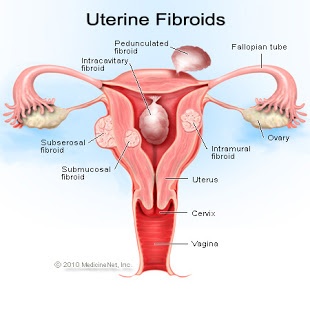WHY MORE & MORE YOUNG LADIES ARE SUFFERING FROM FIBROIDS
Fibroids are the most common benign tumors in females and typically found during the middle and later reproductive years. While most fibroids are asymptomatic, they can grow and cause heavy and painful menstruation, painful sexual intercourse, and urinary frequency and urgency. The condition is more common in African women and studies have revealed that more and more Nigeria young ladies are now from suffering from Fibroid. And why this is so alarming is the fact that Fibroid used to be more common in the older women, most of the time after their stopped bearing children and are in the menopausal stage. In this report, BOLA AKINBOADE brings to you all you need to know about this health problem, the causes , symptom and prevention.
WHAT IS FIBROID
A uterine fibroid is the most common benign (not cancerous) tumor of a woman’s uterus (womb). Fibroids are tumors of the smooth muscle that is normally found in the wall of the uterus. They can develop within the uterine wall itself or attach to it. They may grow as a single tumor or in clusters. Uterine fibroids can cause excessive menstrual bleeding, pelvic pain, and frequent urination; so even though they are termed “benign (not cancerous) tumors,” fibroids potentially can cause many health problems. Its one of the leading cause of hysterectomy (removal of the Uterus) in Africa today. It’s actually more common with African women than the Caucasians. Studies have also revealed that close to 80% of Nigerian women now suffer from Fibroids. Fibroids start in the muscle tissues of the uterus. They can grow into the uterine cavity (submucosal), into the thickness of the uterine wall (intramuscular), or on the surface of the uterus (subsersoal) into the abdominal cavity. Some may occur as pedunculated masses (fibroids growing on a stalk off of the uterus). Although these tumors are called fibroids, this term is misleading because they consist of muscle tissue, not fibrous tissue.
TYPES OF FIBROIDS
Uterine Fibroids are classified by their location, which effects the symptoms they may cause and how they can be treated. Fibroids that are inside the cavity of the uterus will often cause bleeding between periods and often cause severe cramping. Fortunately, these fibroids can usually be easily removed by a method called HYSTEROSCOPIC RESECTION, which can be done through the cervix without the need for an incision.
SUBMUCOUS MYOMAS are partially in the cavity and partially in the wall of the uterus. They too can cause heavy menstrual periods (menorrhagia), as well as bleeding between periods. Many of these submucous fibroids can also be removed by hysteroscopic resection.
INTRAMURAL MYOMAS are in the wall of the uterus, and can range in size from microscopic to larger than a grapefruit. Many intramural fibroids do not cause problems unless they become quite large. There are a number of alternatives for treating these, but often they do not need any treatment at all.
SUBSEROUS MYOMAS are on the outside wall of the uterus, and may even be connected to the uterus by a stalk (pedunculated fibroid.) These do not need treatment unless they grow large, but those on a stalk can twist and cause pain. This type of fibroid is the easiest to remove by laparoscopy.
WHO GETS FIBROID
Most of the time, fibroids grow in women of childbearing age. But it has been revealed that over 70% of these women could have the condition without knowing. There have also been reports of rare cases in which young girls who have not yet started their periods (pre-pubertal) had small fibroids.
DIAGNOSIS OF FIBROIDS
Fibroids may be felt during a pelvic exam, but many times myomas that are causing symptoms may be missed if the examiner relies just on the examination. While a bimanual examination typically can identify the presence of larger fibroids, gynecologic ultrasonography (ultrasound) has evolved as the standard tool to evaluate the uterus for fibroids. Sonography will depict the fibroids as focal masses with a heterogeneous texture, which usually cause shadowing of the ultrasound beam. The location can be determined and dimensions of the lesion measured. Also magnetic resonance imaging (MRI) can be used to define the depiction of the size and location of the fibroids within the uterus.Imaging modalities cannot clearly distinguish between the benign uterine leiomyoma and the malignant uterine leiomyosarcoma, however, the latter is quite rare. However fast growth or unexpected growth such as enlargement of a lesion after the menopause raise the level of suspicion that the lesion might be a sarcoma. Also, with advanced malignant lesions there may be evidence of local invasion. A more recent study has suggested that diagnostic capabilities using MRI have improved the ability to detect sarcomatous lesions. Biopsy is rarely performed and if performed, is rarely diagnostic. Should there be an uncertain diagnosis after ultrasounds and MRI imaging, surgery is generally indicated.Other imaging techniques that may be helpful specifically in the evaluation of lesions that affect the uterine cavity are hysterosalpingography or sonohysterography.
CAUSES OF FIBROID
The exact reasons why some women develop fibroids are unknown. Fibroids tend to run in families, and affected women often have a family history of fibroids. Women of African descent are two to three times more likely to develop fibroids than women of other races. Fibroids grow in response to stimulation by the hormone estrogen, produced naturally in the body. These growths can show up as early as age 20 and shrink after menopause when the body stops producing large amounts of estrogen. Fibroids can be tiny and cause no problems, but they also can grow to weigh several pounds. Fibroids grow slowly. The following factors have been associated with the presence of fibroids:
OVERWEIGHT/OBESITY: Women who are overweight or obese for their height (based on body mass index) are slightly higher risk for fibroids than women who are average weight for their height.
NULLPARITY: Never having given birth to a child (called nulliparity), women who have given birth appear to be at lower risk for fibroid.
MENSTRUAL PERIOD: Onset of the menstrual period prior to age 10
SYMPTOMS
Most fibroids, even large ones, produce no symptoms. These masses are often found during a regular pelvic examination. When women do experience symptoms, the most common are the following: irregular vaginal bleeding or an increase in menstrual bleeding, known as menorrhagia, sometimes with blood clots; pressure on the bladder, which may cause frequent urination and a sense of urgency to urinate and, rarely, the inability to urinate; pressure on the rectum, resulting in constipation; pelvic pressure, “feeling full” in the lower abdomen, lower abdominal pain; increase in size around the waist and change in abdominal contour (some women may need to increase their clothing size but not because of a significant weight gain); infertility which is defined as an inability to become pregnant after 1 year of attempting to get pregnant; and/or
a pelvic mass discovered by a health care practitioner during a physical examination; fever or night sweats; dizziness, lightheadness, shortness of breast, or chest pain associated with vaginal bleeding and vaginal bleeding associated with pregnancy or possible pregnancy.
THE MOST COMMON PROBLEMS CAUSED BY FIBROIDS
Heavy or long menstrual periods. Periods may last more than seven days and menstrual flow may be very heavy. Some women find they need to change sanitary napkins or tampons so often that they cannot function normally during their period. Heavy menstrual flow can sometimes lead to anemia.
Pressure on other organs: Large fibroids may press on organs in the pelvis. If fibroids press on the bladder, a woman may feel the urge to urinate frequently. She may pass only small amounts of urine and she may feel as though she has not completely emptied her bladder. If fibroids press on the bowel, she may feel constipated or full after eating only a small amount of food. If fibroids press on one or both ureters (the tubes connecting the kidneys to the bladder), they may partially block the flow of urine. A woman may not be aware of this because it often isn’t painful. Over time, however, this kind of blockage can lead to kidney infections or other serious kidney damage.
Pain in the pelvis: The pressure of large fibroids on other organs may cause pain in the pelvis. Sometimes, if fibroids do not get the blood flow they need to sustain themselves, they degenerate or die. This may cause severe pain lasting for days or weeks. Pain may also occur if the stalk of a fibroid twists, cutting off blood supply to the fibroid. Rarely, a fibroid may become infected and cause pain.
Anaemia and Iron Deficiency:Fibroids that lead to heavy vaginal bleeding lead to anemia and iron deficiency.
Infertility: Fibroids may also present alongside endometriosis, which itself may cause infertility.
MEDICAL TREATMENT
The vast majority of fibroids grow as a woman gets older, and tends to shrink after menopause. Obviously fibroids that are causing significant symptoms need treatment.
While it is often easier to treat smaller fibroids than larger ones, most of the small ones never will need to be treated. So just because we can treat fibroids while they are small, it doesn’t follow that we should treat them. And many women have successful pregnancies without removing the fibroids as long as they are not inside the uterine cavity. The location of the fibroids plays a strong influence on how to approach them.
Symptomatic uterine fibroids can be treated by: medication to control symptoms,
medication aimed at shrinking tumours , ultrasound fibroid destruction , various surgically aided methods to reduce blood supply of fibroids , myomectomy or radio frequency ablation or hysterectomy(removal of the uterus).
Latest posts by bebeakinboade (see all)
- HOW TO DRESS LIKE PARISIAN WOMEN: ACHIEVING EFFORTLESS CHIC - August 14, 2024
- THE BRAVE ADVENTURE OF JOSH THE GREAT: A FAITH-FILLED JOURNEY OF COURAGE AND FORGIVENESS - August 14, 2024
- FASHION AND BEAUTY ICONS FROM AROUND THE WORLD - July 28, 2024






Hello Dear, are you in fact visiting this web page regularly, if so then you will definitely get fastidious experience.
Have a look at my web page – How To Get Pregnant with PCOS
I am now not certain where you're getting your information, however great topic. I must spend some time learning much more or working out more. Thanks for excellent info I used to be searching for this info for my mission.
Also visit my homepage … Grow Taller 4 Idiots
you forgot to mention UFE as a non-surgical option for patients to get rid of their fibroids.